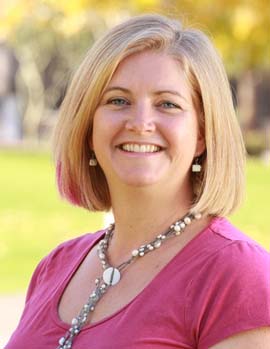Sex-trafficking survivor network aims to 'make a difference to this one'

An Arizona State University professor is part of an innovative new program by the city of Phoenix to help survivors of sex trafficking find new lives.
The Phoenix City Council approved a plan Dec. 14 to provide housing and support services so victims can become self-sufficient and leave their abusive pasts.
Dominique Roe-Sepowitz, director of ASU’s Office of Sex Trafficking Intervention Research, will help city staff design the therapies for the 15 clients who are accepted into the program, called Phoenix Starfish Place. She works with many survivors and has run several focus groups, asking participants what they need most.
Dominique Roe-Sepowitz will help the city of Phoenix design therapeutic services for sex-trafficking survivors in a new housing program.
“What we’ve learned is that getting into sex trafficking is complicated, and getting out is equally as complicated,” said Roe-Sepowitz, who also is an associate professor in ASU’s School of Social Work.
“The constant drumbeat is that they need a place to live,” she said. Survivors frequently have criminal records because their traffickers also force them into robbery, shoplifting and other crimes.
“So our clients have a difficult time finding a safe place to live and a stable community where the neighbor isn’t a drug dealer or a pimp.”
The name comes from a popular motivational story in which a man sees tens of thousands of starfish stranded on a beach. When the man sees a small boy throwing individual starfish back into the sea, he tells the boy it won’t make much of a difference. The boy picks up a starfish and says, “It will make a difference to this one.”
Services at Phoenix Starfish Place will include support groups and skills training for the survivors and their children, as well as prevention groups. Clients are expected to move in later this year.
“One of the big things that came out of the focus groups is that we know this is an intergenerational problem. Children of trafficking victims are significantly more likely to be trafficking victims themselves,” she said.
The community, which Roe-Sepowitz believes will be the first in the country, will be based on a “sanctuary model.”
“We know most of our clients who are trafficked come into that situation with lots of childhood trauma, maybe incarcerated parents. A sexual-abuse history is very prevalent, and emotional abuse,” she said. “The abusive relationship with the trafficker is very traumatic.
“The sanctuary model creates an environment and a community in which everyone understands the trauma related to this, and responds with that in mind,” said Roe-Sepowitz, who has already started training employees in the city’s housing department.
“Everyone involved will have an understanding of what trafficking is so they can serve these clients with dignity and respect.”
Gathering data
The average age of entry into sex trafficking is 14, according to ASU’s Office of Sex Trafficking Intervention Research. Many of the young people have a history of running away or drug abuse and may be lured by older “boyfriends,” who begin by offering affection and support before forcing victims into prostitution.
In Arizona, the law-enforcement and justice systems began changing their response to trafficking over the past decade, viewing young prostitutes as victims of traffickers rather than criminals. In 2013, Phoenix Mayor Greg Stanton created the Human Trafficking Task Force, charged with increasing both prevention and services. In 2014, the state beefed up penalties for traffickers and johns and helped to protect minors from criminalization.
The Office of Sex Trafficking Intervention Research was launched in ASU’s School of Social Work in 2013. Since then, the center has produced several research projects, including a paper released this month revealing the results of a three-year survey of 199 homeless young adults in Arizona that found that a third reporting being sex trafficked.
The office also explored the before- and after-effects of the 2015 Super Bowl in Glendale on sex trafficking in Phoenix. Their study found that the event itself does not necessarily increase sex trafficking, but that “traffickers will bring their victims wherever there is demand and money.”
In 2014, Roe-Sepowitz was part of a teamRoe-Sepowitz was awarded the funding, from the U.S. Department of Health and Human Services Administration for Children, Youth and Families, along with Judy Krysik, an associate professor and the director of the Center for Child Well-being in the School of Social Work. The project is a collaboration among the Office for Sex Trafficking Research Intervention, the ASU Center for Applied Behavioral Health Policy and the Arizona Department of Child Safety. that won a $1.24 million grant to help identify young trafficking victims in Arizona and to train child-welfare professionals to improve outcomes.
Cathy Bauer, the diversion program manager at Catholic Charities Community Services, said she has seen attitudes in the city “change 180 degrees” over the past decade. She runs the Dignity program, which allows clients to have misdemeanor prostitution charges dismissed upon completion. But she said that housing for women with children has been the missing link.
“A lot of times people can take a step up to that program that will take them to the next level in life, but if they can’t take their children, they can’t go,” said Bauer, who will be able to refer clients to the Starfish program. “To get a place like Starfish with safe, adequate housing with services is phenomenal.”
Roe-Sepowitz said her work on Phoenix Starfish Place will involve ASU students, including the 10 undergraduate and graduate students currently working in the Office of Sex Trafficking Intervention Research.
“We’ll be evaluating the housing program and getting feedback on their quality of life, quality of safety, quality of community,” she said.
“It’s a really unique opportunity to collect data for students, and I hope it will support honors theses and graduate theses and maybe some dissertations.”


